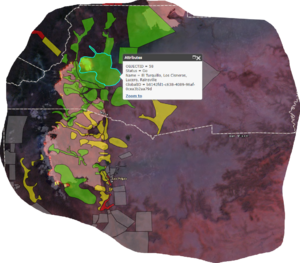Difference between revisions of "Wildfires"
David Jones (talk | contribs) m (added details in the table below) |
David Jones (talk | contribs) |
||
| Line 1: | Line 1: | ||
| + | [[File:HermitsPeakFire-VIIRSfireTempRGB-EvacOrders-Freehand-2022-05-09 173304.png|thumb|Hermit's Peak evacuation orders. This wildfire started out as a prescribed burn that got out of control and became New Mexico's largest wildfire in its history in 2022.]] | ||
The ESIP community rallies around big issues and brings creative and sometimes non-traditional approaches that make perfect sense. Help us define the future as we open the doors to open '''wildfire science''' and '''proactive solutions in wildfire management.''' The newly formed '''ESIP Wildfire Cluster''' invites your input to help us define the future of wildfire management. We anticipate on providing an area for conversation and networking that would initially serve two key stakeholder communities: | The ESIP community rallies around big issues and brings creative and sometimes non-traditional approaches that make perfect sense. Help us define the future as we open the doors to open '''wildfire science''' and '''proactive solutions in wildfire management.''' The newly formed '''ESIP Wildfire Cluster''' invites your input to help us define the future of wildfire management. We anticipate on providing an area for conversation and networking that would initially serve two key stakeholder communities: | ||
Revision as of 13:32, January 31, 2023
The ESIP community rallies around big issues and brings creative and sometimes non-traditional approaches that make perfect sense. Help us define the future as we open the doors to open wildfire science and proactive solutions in wildfire management. The newly formed ESIP Wildfire Cluster invites your input to help us define the future of wildfire management. We anticipate on providing an area for conversation and networking that would initially serve two key stakeholder communities:
- Any community working with wildland and prescribed fires for proactive solutions in management including Wildland Firefighters, Fire District Chiefs, Fire practitioners, Land managers and even communities – to evolve the wildfire cluster to see how we can address key issues related to the use of geospatial products, remote sensing, AI, ML and technologies that can guide their decision making or introduce new approaches that can assist them.
- Any agency or organization focusing on wildland fire management that can benefit from an ESIP community that shares an interest in applying technology and ideas that result in building something together or coming up with new technological priorities or approaches that the ESIP community could help define around how trusted wildfire data and information can be applied to proactive management of wildland and prescribed fire.
- Any ESIP member who wants to participate in this cluster and discuss how we might apply new and emerging technologies to address proactive wildfire management.The ESIP Wildfire Cluster will be open and inclusive with the goal of bringing together interested members of the community to come up with ideas and potential GIS-related products that can be derived from remote sensing platforms, in situ observations or model data, that could address priorities identified by fire districts across the nation beginning with a Fire District in CA. This cluster will also invite members of NASA’s Wildland Fire Management Program, NOAA, USFS and state agencies to participate on occasion and be a part of the conversations.
The cluster will also look to leverage the ESIP Ecosystem of Innovation developed by the Disaster Lifecycle Cluster to see if it is applicable in addressing Wildfire Cluster priorities and placing any prototype products in front of real decision makers that are in a position to be involved in proactive management of wildfires. In addition, the wildfire cluster will look to collaborate with other relevant ESIP clusters to build upon the excellent work and conversations that occur every month during their respective meetings and to make sure there is no duplication of efforts.
Come and be a part of the conversation as we firm up the direction of this new exciting ESIP Wildfire Cluster as we look to build an open science approach to addressing one of the nation’s most destructive events that is getting worse. The cluster will meet on the SECOND WEDNESDAY of every month at 4pm ET. This monthly meeting will be hosted in the ESIP Zoom platform. The link can be accessed below.
This cluster launched in January 2023 during the ESIP Winter Meeting and we are excited to welcome anyone who has an interest in wildfires and data. There are major challenges to putting data to work to serve decision makers when those decision makers are non-technical. We welcome your input and contributions as we tackle yet another challenge within ESIP. Here is a short video presented at the first cluster meeting of Fire Chief David Winnacker describing what he would like access to in order to improve his ability to use 'good fire' to restore the ecosystem to balance while fighting the 'bad fire' in order to protect life and property. This was recorded as part of the ESIP Disaster Lifecycle Cluster meeting on October 6, 2022.
News
|
ActivitiesWildfire cluster meets the 2nd Wednesday of each month starting on March 8, 2023 at 4pm ET. Zoom link will be provided below once it has been set up. |
Get Involved
|
Resources |
